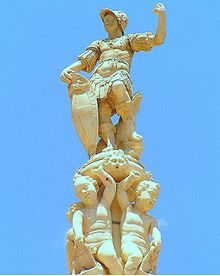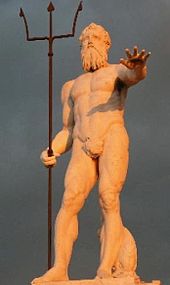- Giovanni Angelo Montorsoli
-
Giovanni Antonio Montorsoli (ca. 1506 -1563), also known as Fra Montorsoli, as Michele Agnolo and as Angelo di Michele d' Angelo da Poggibonsi, was an Italian sculptor.
Biography
Born in Florence and member of the Servite Order, he was employed from 1521 to 1534 as one of Michelangelo Buonarroti's assistants at the Medici Chapel (Sacrestia Nuova) in San Lorenzo in Florence. He is known to have sculpted St. Cosmas with another of Michelangelo's assistants, Raffaello da Montelupo, after a model by the master. In 1532-1533 he produced his Drunken Satyr. This sculpture was probably intended for a wall fountain, possibly situated in a niche where the water would have flown from the open neck of the satyr's wineskin. This would have been in a style very popular at the time in Rome. Due to the large number of ancient sculptures in Rome, these tended to be utilised rather than commissioning a new figure. However, in Florence ancient statuary was far less available. Montorsoli's Satyr, with its classical theme and distinctly classical style, was intended to fill the void.
In 1532 he was summoned by Pope Clement VII to the Belvedere courtyard to restore many of the antique sculptures there. This included the Laocoön group and the Belvedere Torso. (Restoration methods in that epoque entailed reworking sculptures in accordance with contemporary aesthetic principles which often were at odds with the aesthetics of antiquity. For instance, Montorsoli included a new right arm in the central figure of the Laocoön group, upraised in a gesture of defiance, adding much to the fame of the sculpture and himself. However, when the original limb was found in 1905 in Rome and reattached to the Laocoön schulpture, replacing Montorsoli's work, the original was revealed to be folded at the elbow with considerably less flourish.) In 1547 he left Florence and went to Messina where he procured a commission for the Fountain of Orion, the mythical founder of Messina. When erected, the Fountain of Orion was the tallest and largest of its day and was much admired by Vasari. It is a candelabrum type like the fountains at the Medici villa at Castello by Tribolo, but it has evolved. The receiving basin is polygonal, contrasting with the circular basins above. The sculpted creatures supporting the second basin are carved in deep relief, but the female nudes above them appear to be carved in the round. They have become sculptures in their own right, and are not just there to decorate the shaft, or to draw the eye upwards to the figure at the summit. This is the candelabrum type at its pinnacle. In 1551 this fountain was largely finished, and he was commissioned for another fountain - the Fountain of Neptune.
This was a complete break with tradition with regards to fountain design. Previously fountains had mainly been either a basin with a small figure, such as Donatello's winged infant and Rustici's Mercury of 1515, or a wall fountain, or a candelabrum type. The Fountain of Neptune is completely different. It is a fountain type with one main raised central figure, and this type had never been done before. The only precedent for it was a design by Benvenuto Cellini for the French King at Fontainebleau. In the middle of the fountain Cellini wanted to erect a "pedestal, projecting somewhat above the margin of the basin, and upon this a nude male figure" which was to represent the King himself as Mars. This never came into being though, and therefore the Neptune at Messina is the first of its type. The Fountain of Neptune makes very good use of contrasts. The God of the Sea is arranged in a classical, static pose. Yet below him the figures of the sea monsters Scylla and Charybdis writhe around and draw back in terror. Scylla and Charybdis were the names of rocks near the harbour of Messina; as they had wrecked so many ships, they came to be personified by sea monsters. Neptune's act of warding off these destructive forces demonstrates his power and his protection of the city. This work was especially influential in Florence where there was a love of the colossal, and it may have led to the plans for the Neptune Fountain in the Piazza della Signoria in Florence. In Florence there was a predilection for having many small thin elegant jets of water, even when there was enough water to have a large geyser. Montorsoli carried this Florentine tradition of having smaller, elegant jets, and judging from a design of his in the Uffizi he used eight of them for his design for the Neptune fountain. The Fountain of Neptune was finished in 1557. In Messina he also realized the St. Lorentz Church (from 1552, destroyed in the earthquake of 1783), the Lantern Tower (1555) and the Apostolate within the Cathedral (completed in 1555, destroyed several time by fires and earthquakes, and rebuilt).
Montorsoli left some works in Genoa in the church of St. Matthew, commissioned by Andrea Doria for his tomb and some sculptures.
See also
References
- Bruce Boucher (1998). Thames & Hudson, World of Art. ed. Italian Baroque Sculpture. pp. 91–92.
- Blake Wilk, Sarah (1987). "Civic Sculpture in the Renaissance: Montorsoli's Fountains at Messina". Renaissance Quarterly: p.114–116.
- Wiles, Bertha, H. (1933). The Fountains of Florentine Sculptors and their Followers from Donatello to Bernini. New York: Hacker Art Books.
- Poeschke, Joachim (1996.). Michelangelo and His World. New York: Harry N. Abrams.
- Cellini, Benvenuto (1889). Autobiography. London: John C. Nimmo.
Categories:- 1500s births
- 1563 deaths
- People from Florence
- Italian sculptors
Wikimedia Foundation. 2010.



